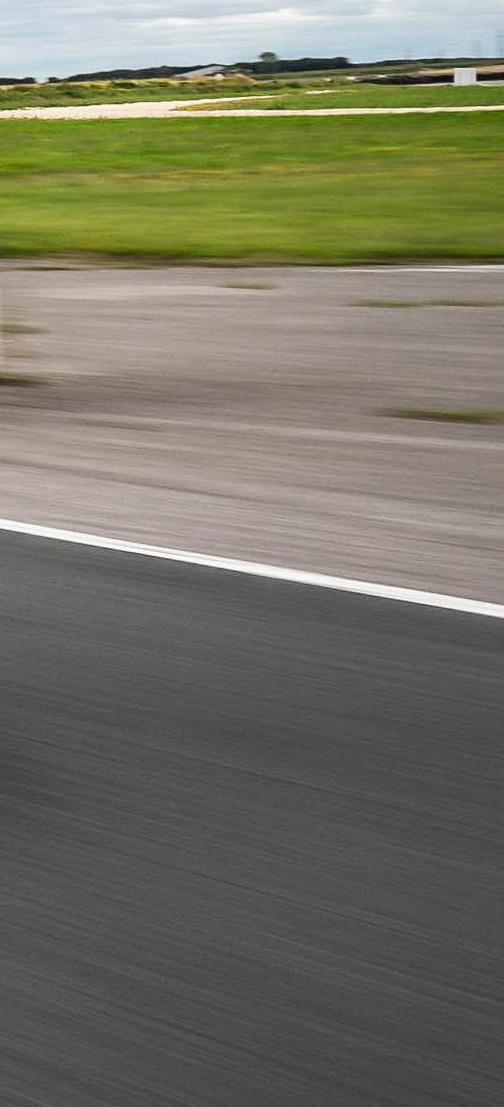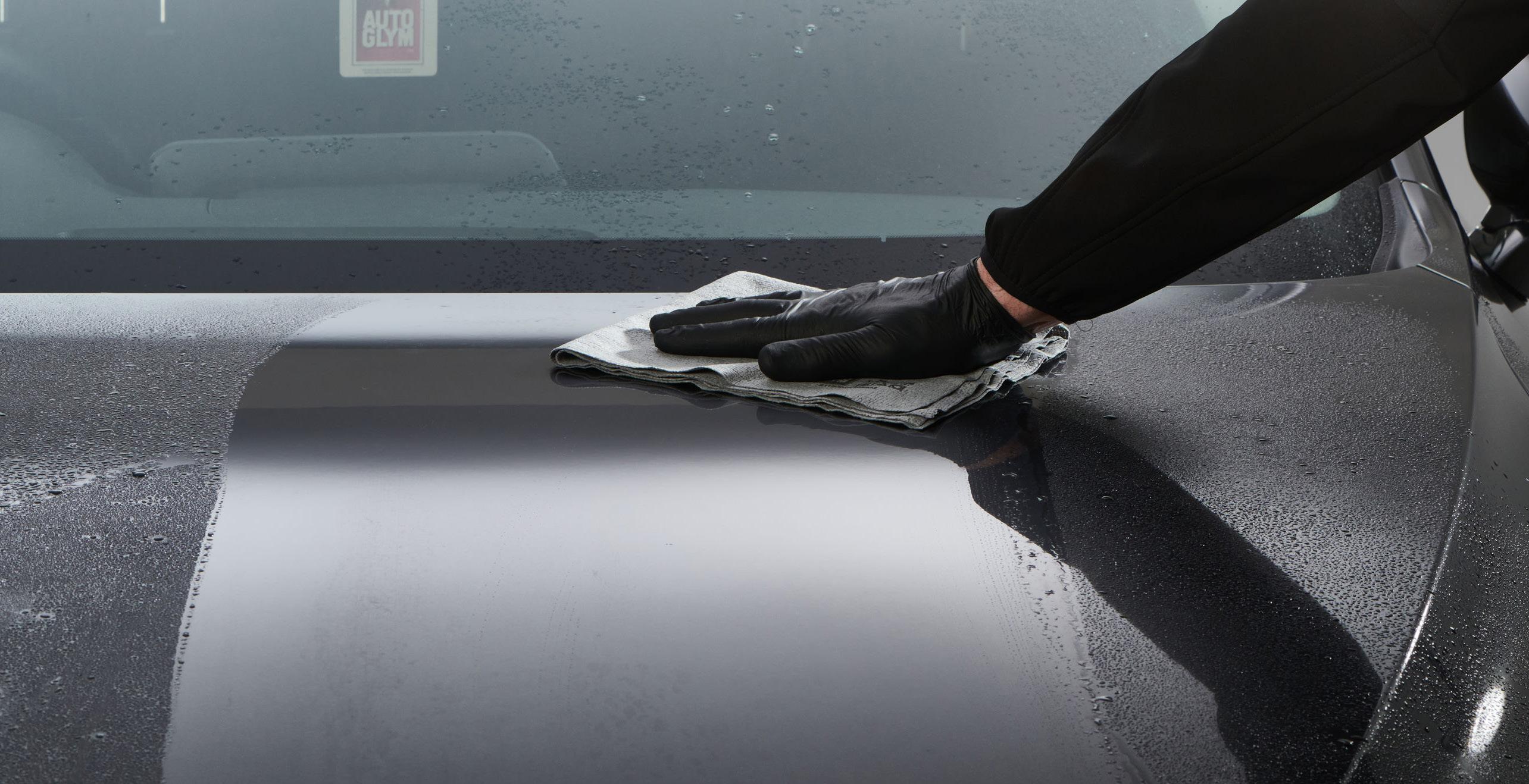
11 minute read
Fast and curious
FAST& CURIOUS!
Ted Welford spends a day with motor racing coach Mark Hales to learn the skills needed for safer track driving.
Even away from the car, Mark can teach how to gain speed

If you’ve spent any amount of time on the UK’s roads recently, you’ll probably also be thinking about how many different standards of driving you’ll see.
From those oblivious to what lane they’re in on the motorway to others glued to their phones as if there’s a magnetic field, there are plenty of areas for improvement.
This change in standard of driving is perhaps to be expected, though. As a result of lockdowns, many went from driving their car on a daily basis to only using it a handful of times in a month while also remaining local, and it’s only natural for a skill to get worse if not practised regularly.
Mark Hales is a racing driver-turned-journalist who now spends most of his days teaching people how to drive. But we’re not talking about those sticking L-plates on their car for the first time, rather how to drive quickly and safely. We’re on the test track today, but there is quite a lot of overlap between this and road driving, with a surprising amount of rules that should be applied to every journey.
Blyton Park is a lesser-known racetrack near Gainsborough in Lincolnshire. It’s a relatively new circuit too, being repurposed from its original use as an airfield just a decade ago. That said, it’s played an important role in the development of some well-known racing drivers, not least current F1 driver Lando Norris.
Our wheels for the day are pretty good, too: Hales’s Mazda MX-5 that he uses as his everyday transport. With its combination of lightness, rear-wheel drive and manual gearbox, it’s the ideal choice to get to grips with track driving.
We actually start the day nowhere near the driving seat of the MX-5 but in a portable building at the back of the track. Think detention in secondary school and you’d get the picture. But it’s this ‘grounding’ that is key to learning the basics – I should point out that this is my first experience of driving on a track, so we’re very much at a novice level.
Hales kicks off the day with some stark advice: ‘You can’t know how to do this. Having a licence shows you how to operate a car and control it safely on roads, but you have to override your natural instinct as a matter of safety if you want to drive quickly.’ No pressure then.
As someone who’s driven everything from historic racers to modern hypercars on track – as well as almost priceless Ferrari 250 GTOs – Hales knows more than most, and he’s clear that we have to understand the science behind driving quickly. It’s why we spend part of the day learning about grip levels and understanding weight transfer by looking at Venn diagrams.
But the first bit of advice we learn is what needs to be applied to all driving, and it’s



Back in the classroom!

Below: Mark Hales instructs Ted on how to get the most from the MX-5

something that’s surprisingly difficult to overcome. While we’re always told to look ahead, it’s all too easy to just focus on what’s directly in front of us. That’s the thing Hales immediately picks up on as soon as we head out on track.
‘Motorists tend to drive looking at the end of the bonnet, but where you look is the most important part of driving,’ Hales tells us in his remarkably calm and unflustered fashion.
‘Where you look is where you will go. You must look where you want to go. Any distraction is significant, and primarily the faster you go, the further up the road you will have to look.’ On track, it means that as soon as you’re coming out of one corner your eyes need to be focused on the next, and always think that one step ahead. It’s a really important rule, and one that seems especially true of driving on public roads.
After some time out on Blyton trying to get my head round this bit, the next part of the day is all about exploring grip levels. It’s something that’s all too easy to forget – although it is a part especially emphasised in snow and ice, for example.
Essentially, Hales is teaching us about reaction times. We’re not talking about our dimwitted responses but those of the car and, predominantly, the tyres. As a driver of any powerful rear-wheel-drive car will tell you, there’s only so much the tyres are capable of doing in terms of gripping the tarmac, and it essentially means you need to steer slightly before you actually want to. We’re talking just a quarter of a second, but the faster you go, the more it becomes apparent.
You also don’t want to ‘surprise’ a tyre, which is why smooth driving is so important rather than slamming a car into a corner, which is when you’re most likely to lose control.
It’s this part of the day that’s the most fun as it’s all about exploring the car’s limits, which – in the case of the MX-5 – is a rather long way. While agile and eager, these little Mazdas rarely feel unsettled and give you the confidence to keep pushing until you get to the ‘danger zone’. Hales calls this the ‘most exciting bit’, and while not something you can or should do on the road, it is hugely enjoyable at Blyton Park, where the combination of fast and flowing corners and sharp left-handers are great for putting what we’ve been taught into practice.
The other key thing we learn about is consistency, since especially during sustained track driving there’s little point being quick unless you can maintain it. As Hales explains, you want to spend the shortest length of of time driving slowly. It might sound pretty obvious, but it gets us into the mindset of not slamming the car into a corner too much because of the time it takes for the MX-5 to get back up to speed.
That said, Hales isn’t always the most impressed by our driving style, especially as the words ‘It’s optional how much you mash the pedals’ are uttered quite loudly at one point. We take things back slightly after this…
But it’s all these little things plus so much more that forges some of the best racing drivers. Even at the age of 72, Hales is a force to be reckoned with. We swap seats on several occasions and the speed at which he can get something like the MX-5 round the track – its 181bhp figure is plenty, but not a lot by performance car standards – is astounding.
It’s clear we’re some way off having the ‘sixth sense’ the best racing drivers have, but it feels like we’re a long way ahead of where we were just a few hours earlier.
And with some of these rules applicable to our drive home and beyond, there’s plenty that time on track can teach you overall about driving. Hopefully, it won’t be long before we’re back on a circuit again…
BY APPOINTMENT TO HER MAJESTY THE QUEEN SUPPLIER OF CAR CARE PRODUCTS AUTOGLYM, LETCHWORTH, ENGLAND BY APPOINTMENT TO H.R.H.THE PRINCE OF WALES SUPPLIER OF CAR CARE PRODUCTS AUTOGLYM, LETCHWORTH, ENGLAND
REFL OW



IMAGINE REMOVING BIRD DEPOSIT ETCHING WITH
NO WET SANDING NO BUFFING MACHINE NO HOLOGRAMS NO SWIRL MARKS NO PIGTAILS NO RISK
Reflow is a breakthrough treatment that permanently removes etching marks and dull spots, caused by bird deposits, from car paintwork*.
Developed by Autoglym, Reflow is an innovative solution to one of the most common problems in car care – paintwork damage caused by bird deposits. Reflow is safe, easy to use and requires no specialist tools and takes just 30 minutes to effectively heal vehicle paintwork, leaving a perfect finish once again.
WATER ACTIVATION
Cold water is added to pack to activate, pack is placed on affected area and left for 30 minutes. THERMAL TRANSFER
Pack heats surface to optimum temperature allowing paintwork to reflow and fill imperfections. PAINT HEALING
As pack cools, paintwork sets effectively healing affected area, pack is removed − etching disappears.
*Important note: Reflow works best on new or nearly new vehicles, with clear coat, that are up to three years old. If paintwork is aged, Reflow will significantly improve the appearance of the etching but might not remove it completely.
Autoglym autoglym.com
For used cars as well as new

September 2021 will be remembered in the car industry for all the wrong reasons after the semiconductor chip crisis, allied with underlying post-lockdown economic uncertainty and stricter lending criteria, delivered the perfect storm to a struggling new car market.
All of which makes selling new cars hard work – if, indeed, you can even get hold of them.
This is leading clever retailers towards stocking up their used car supply, against stiff competition from online resellers and car supermarkets.
The average price of a used car rose by £822 between June and September according to research by Motors. co.uk, with those priced between £10,000 and £15,000 the most in demand and the fastest to sell, which shows both an underlying level of demand in the market that new car availability simply cannot meet and a slightly more positive evaluation of the economy.
Dermot Kelleher, head of marketing and research at eBay Motors Group, which owns Motors.co.uk, said: ‘The used car market continues to experience an intense period of diverse market dynamics, with some strong price rises being driven by unsated buyer demand, combined with ongoing restrictions in stock supply.
‘On Motors.co.uk we’ve tracked a rise in retail prices since June and expect this to continue into Q4 and possibly beyond.’
Motors.co.uk identified the Ford Edge, MG ZS and Kia Sorento as its most in-demand and fastest-selling used cars, proving that SUVs remain popular with family customers and private motorists.
Meanwhile, according to car sales site Buy My Car, a well-cleaned and maintained car can achieve a sales price of up to 10 per cent more than average. At the start of 2021, the average used car price in the UK was £14,100, meaning a clean and well-presented car could be worth as much as £1,410 more on average.
But how do used car sales sites ensure that their stock stands out in an increasingly demand-driven market?
Paul Caller, CEO of Autoglym, said: ‘Never has cleaning or detailing used cars been more important, and at Autoglym we offer multiple ways of doing that.
‘The first step is to get your cars detailed and valeted with easy-to-apply, great-quality products from our Professional range, which deliver exceptional, instant and long-lasting results, covering all areas from bodywork and exterior trim to under the bonnet and – of course – inside the cabin. Used car buyers don’t always want to buy a used car, so the job of the valeter is to eradicate all traces of previous ownership.
‘When that’s done, LifeShine comes in – it’s not just for new cars. A lot of people assume that paint and interior protection products can only be applied to new models, but the truth is that used and nearly-new cars – and their owners – can enjoy the same benefits and the same lifetime guarantee, so a LifeShine application to protect that just-cleaned and detailed finish is a smart move.’
That’s great news for customers but also for dealers who previously may only have considered selling LifeShine to new car customers. It works just as well on a used car, and given the booming values of used cars in a highly competitive market, it makes a lot of sense to give sales staff something incentivised to help out as the car industry continues to face new challenges.
Finally, don’t forget under the bonnet – it’s as important as the exterior and interior – and a great set of photos that highlight how clean the car is. A clean car minimises the reasons why a customer might walk away or haggle on price.

Paul Caller, CEO of Autoglym











